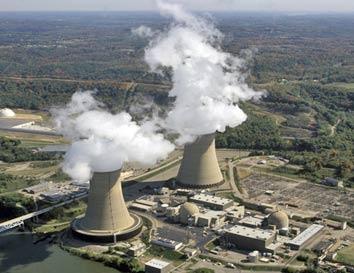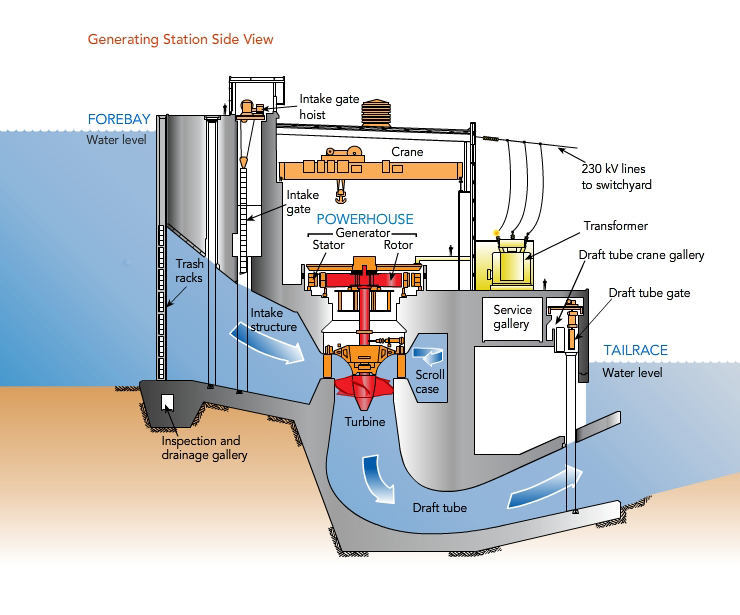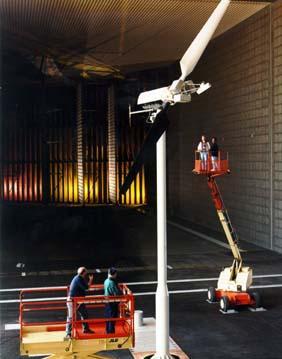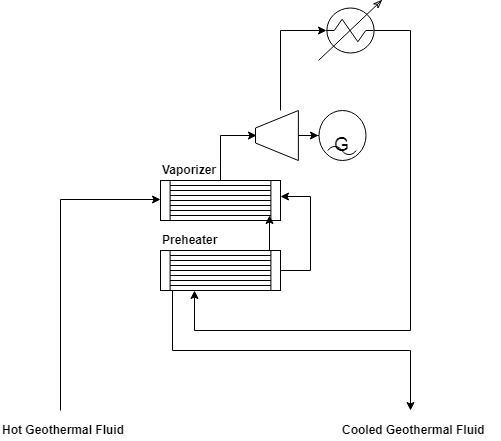Energy processing involves an array of chemical engineering equipment and can be divided into three stages: Generation, storage, and usage. Generation of energy is the process of harvesting energy from a particular source, energy storage involves the system used to contain the harvested energy, and the stored energy is then sent to its final destination to be used and conserved in a multitude of different applications. Storage of energy can be found in further detail in the Energy Storage module. Energy can be generated from a variety of sources, including fossil fuels, wind, solar, hydro, tides, geothermal, and nuclear power. These energies can be categorized into renewable and nonrenewable energy types.
Nonrenewable Energy
This type of energy refers to those from sources formed naturally over time that cannot be regenerated in the short term. Such energy sources come mainly from fossil fuels and are processed to produce coal, petroleum, natural gas, and various plastics.
Coal Powered Energy Generation
A multitude of processes are involved in coal processing but the bulk of it involves material handling and chemical and mechanical separations. Coal is first extracted from an open-pit mine and transported to a mobile primary sizer to reduce the product down to a manageable size. The coal exits the sizer by flowing on the mine’s conveyor belts to a secondary sizer, where it is mixed with another coal source from underground mining operations that travels through a mine shaft system. This product is then sent to a drum before it is drained, rinsed, and screened by a screener.
The fine coal settles in a slurry and then enters a magnetic separator that further separates magnetic minerals and other unwanted material from the coal. The product from this process then undergoes coal classification by being washed in hydrocyclones, and classifiers. Hydrocyclones wash and clean the coal to allow a density-driven separation to occur, as minerals are denser than the coal. The hydrocyclone is designed to segregate the finer coal particles as they exit the bottom of the conical equipment. These particles are filtered further by screeners before proceeding to a coal dryer. The product is sent to a grinding mill for the final size reduction before being used for coal power generation.
Fine and pulverized coal retrieved from processing plants is burned in the combustion chamber of a boiler, where it is then mixed with hot air. This generates steam through the boiler, and the high-pressure steam then passes through a turbine that converts thermal energy into rotational energy. The turbine is connected to a generator that produces electricity as the turbine rotates in a strong magnetic field. After passing the turbine, the steam is condensed back into a liquid and is recycled back to the boiler.
Natural Gas Combined Cycle
In the United States, many coal power plants are being converted into natural gas combined cycle power plants to meet the Clean Power Plan and other EPA emissions regulations. The transition gives a greener incentive as natural gas releases much less carbon dioxide into the atmosphere than coal per unit output and requires less back-end emissions treatment. A detailed section on natural gas processing and energy generation is available.
Nuclear Energy Generation

This type of energy generation involves nuclear power plants that include a nuclear reactor, and various types of heat exchangers such as the cooling towers and condensers, described in their respective modules. Nuclear power plants transform water into steam using the heat released from nuclear fission in the reactor. The steam generated turns the turbine blades where its rotational energy is transformed into electrical energy with the aid of generators. The steam then passes through the cooling tower, is cooled down into a liquid state, and is transported back to the power plant.
Crude Oil Energy Generation
The process of petroleum generation and corresponding refinery processes is described in the petroleum refining module.
Renewable Energy
Renewable energy is garnered from sources that are naturally replenished. Hydro, solar, wind, and geothermal power are the important renewable energy technologies currently being implemented.
Hydropower

Hydropower is generated by the use of turbines installed in dams that generate electrical power as the water rushes through them. Its corresponding storage unit is further elaborated in the Pumped Hydroelectric System under Energy Storage.
Solar Power
The basis of solar power is the conversion of sunlight into usable energy. The vast majority of solar power processes create usable energy in the form of electricity using a system of concentrating mirrors and voltaic cells. These processes can be divided into solar cell energy generation and solar thermal energy generation. The biggest difference is that solar cells can directly convert absorbed sunlight into electricity, whereas solar thermal energy systems must first convert sunlight into heat, and then convert heat into energy.
Wind Power

This type of power generates electrical energy through the implementation of wind turbines, which can be found in the wind section of the turbines module.
Geothermal Power
Geothermal power plants use heat from the reservoirs of hot water found under the Earth’s surface.
The major components of a geothermal power plant are the cooling towers, electrical substations, and chemical engineering equipment such as heat exchangers, condensers, and turbines. A geothermal power plant is analogous to oil drilling rigs in that wells are injected into the earth’s surface to reach a geothermal reservoir with an injection well. This allows hot geothermal fluid to flow up to the power plant so that its heat can be converted to electrical energy. In the power plant, the hot pressurized fluid is first flashed into steam and water. The water is returned to the hot reservoir, and the steam enters a turbine and expands as it generates mechanical energy. This rotational energy then spins through a magnetic field in a generator to create an electrical current, which is then sent to an electrical substation consisting of a step-up transformer. The expanded fluid travels through a condenser to be cooled into a liquid before returning to the hot reservoir.
A geothermal power plant also uses a secondary working fluid, such as ammonia, in a closed-loop system. This working fluid is heated in the hot reservoir and is further vaporized in a heat exchanger. The working fluid assists in electrical energy generation by driving the turbine. It is then condensed back to liquid form before being sent back to the start of the loop by an injection pump. The hot pressurized fluid is separated from the secondary working fluid to prevent any environmental impact.
Usage
Energy can be categorized into primary and secondary energy. Primary energy, such as coal or petroleum, is the initial form of energy that has not been transformed into secondary or tertiary forms of energy, such as electricity. In the United States, the industrial, transportation, residential, commercial, and electric power sectors primarily consume primary energy. In addition, the industrial, transportation, residential, and commercial sectors also consume secondary electrical energy produced by the electric power sectors. In 2016, 81% of energy consumption in the United States came from fossil fuels, petroleum, and natural gas, with only 10% coming from renewable energy and the rest from nuclear energy.
Particularly for solar energy, the produced electricity can be used in two ways. First, the electricity can be directed into a wire and used immediately to power electrical devices, machinery, etc. Alternatively, the electricity can be used to charge a fuel cell, as described in the Fuel Cells module. For large-scale solar power generation, the latter option is preferred, as often the energy is not needed immediately and can be transported or stored for long periods of time.
Acknowledgments
- U.S. Department of the Interior, Bureau of Reclamation, Boulder City, Nevada.
- Aaron Napier
- Andrew Campbell
References
- Baxter, Richard. Energy Storage: A Nontechnical Guide. PennWell, 2006.
- Bouma, John. Shaping A Geothermal Power Plant. 1980.
- FLSMIDTH. Equipments & Systems for Coal Preparation. Salt Lake City: FLSMIDTH, 2011. http://www.flsmidth.com/. 20 Apr. 2011. Web.
- U.S. Energy Information Administration, Monthly Energy Review. Tables 1.3 and 10.1. April 2017.
Developers
- Nuramani Saiyidah Binti Ramli
- James Rivard

